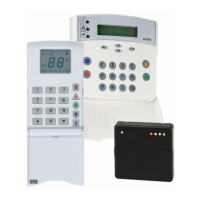Matrix 832 / 832+ / 424
Page 84 RINS428-5
Arm B - When the panel is armed in Arm B mode the engineer can choose which events to report to the
central monitoring station from Alarms, PA alarms, Fire alarms, Maintenance information, Open / Close,
Medical, Confirmed Alarms and omitted (bypassed) zones information.
Arm C - When the panel is armed in Arm C mode the engineer can choose which events to report to the
central monitoring station from Alarms, PA alarms, Fire alarms, Maintenance information, Open / Close,
Medical, Confirmed Alarms and omitted (bypassed) zones information.
Arm D - When the panel is armed in Arm D mode the engineer can choose which events to report to the
central monitoring station from Alarms, PA alarms, Fire alarms, Maintenance information, Open / Close,
Medical, Confirmed Alarms and omitted (bypassed) zones information.
Restoral - When the panel is armed any of the above modes the engineer can choose to enable or disable
events restorals reporting to the central monitoring station from Alarms, PA alarms, Fire alarms, Maintenance
information, Open / Close and Medical information.
Tel1, Tel2, Tel3
The system allows the engineer to allocate 3 different CMS telephone numbers from the 9 numbers available
for reporting each of the following events: Alarms, PA alarms, Fire alarms, Maintenance information, Open /
Close and Medical information.
For instance all events can be sent to Telephone number 1 and 2 and alarm events only to Telephone number
3. In this case Telephone No 1 would be 1
st
CMS number, Telephone No 2 would be 2
nd
CMS number and
Telephone No 3 would be user pager number.
Group Events Reporting Option
These options allow the engineer to decide which groups of alarms are transmitted to the Central Monitoring
Station in the various modes of the Panel. This option should be used to prevent call jam to the CMS in pick
times:
Only Send To 1 - Events to be sent only to telephone number 1.
Always Send To Both - Events to be sent to both telephone numbers.
Only To 2 As Backup - Events to be sent to telephone number 1 and if no communication acknowledged
send to telephone number 2.
NOTE: If telephone number 3 programmed then the panel will always call this number after the
communication to numbers 1 or 2. If only telephone 3 programmed then the panel will not call.
MX-VOICE Messages
You are able to record up to 8 separate voice messages that can be sent by the MX-Voice Module when an
event has occurred. Each event type (alarm, fire, PA, etc.) may have a voice message number associated
with it. There are 8 event types, although open/close is a special case, and allows a separate message for
both open and close. This means that there can be a total of 9 different triggers for a message, to be
distributed over 8 different messages. However, most systems do not need messages for all 9 events, so this
should not be a problem.
Once you have programmed an alarm type with a voice message, you must associate it with a telephone
number that has been programmed as a voice number. If you only want to send voice messages, programme
Tel 1 as voice protocol. If you wish to send both Contact ID and voice messages, programme Tel 1 and Tel 2
as CID number, and Tel 3 as a voice number. This allows the much faster CID protocol to be sent first.
Since voice messages cannot be acknowledged, they will repeat for 1 minute. Also, because there is no
handshake, it is not possible to know if a call has been picked up, or if the line was engaged. Therefore, you
can program the system with the number of times to dial the number. For example, if the repeat number is 1,
the number will be dialled; the message will play for 1 minute, and then hang up. If the repeat is 2, the number
will be dialled; the message will play for 1 minute, and then hang up. The number will be dialled again, and the
message played for another minute. The next event of telephone number will then be processed. Use this
feature with caution, as it may delay other important messages if the repeat number is too high (maximum of 9
repeats).
Restorals of events (e.g., closing a zone or fixing a fault) do not have voice messages associated with them
(this means that upon restoring an event, no voice message will be sent). Once one voice message of a
specific event type has been sent, that particular message will not be sent again in the same set or unset
period. For example, if you get 4 separate zones being activated in one set period only ONE intruder alarm
voice message will be sent. During that same set period, if a PA goes off, the PA voice message will be sent,
but if a further PA is triggered in the same set period, the second activation will NOT cause a voice message.
This limit is reset each time the panel is either set or unset. The purpose of this is to limit the number of
unwanted voice messages.

